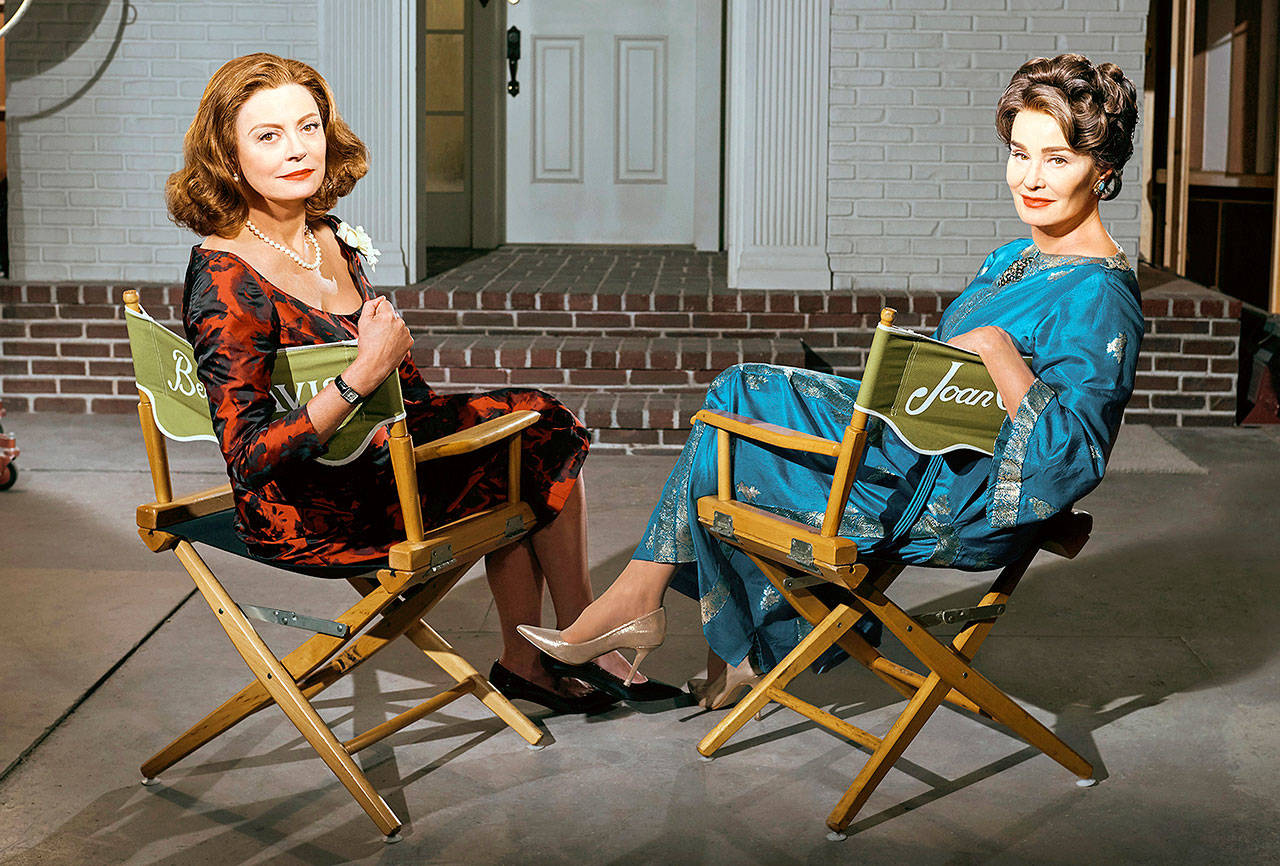By Verne Gay
Newsday
THE MINISERIES: “Feud: Bette and Joan”
WHEN, WHERE: Premieres 10 p.m. Sunday on FX
WHAT IT’S ABOUT: In their mid-50s, Bette Davis (Susan Sarandon) and Joan Crawford (Jessica Lange) needed work. Director Robert Aldrich (Alfred Molina) was looking for respect, and so when Crawford pitched the idea for a horror movie based on a crazy vaudeville child actress, now aged and holding her sister hostage, he shrugged his shoulders: Why not? Jack Warner (Stanley Tucci) is the only studio head who will touch this box office poison, but only on this condition: That Aldrich creates a public feud between the two stars. Aldrich knows just who to call: Hollywood super-gossip-columnist Hedda Hopper. The war begins. When it’s over, nobody wins. At least “What Ever Happened to Baby Jane?” did well at the box office. This five-part miniseries was created by Ryan Murphy.
MY SAY: The 35th Oscars were held April 8, 1963, at the Santa Monica Civic Auditorium, with two legends of the silver screen in attendance. Davis had been nominated for best actress in “What Ever Happened to Baby Jane?” while her bitter rival and co-star Crawford had been snubbed. But when the evening was over, it would be Joan holding the Oscar, not Bette.
How this improbable turn of events came to be is the climax of “Feud: Bette and Joan.” It also happens to be a famous Hollywood story, although variations on its theme have been told long before and since, in novels like “The Day of the Locust” or films like “Sunset Boulevard.” You know: The way this place crushes human souls into dust until all that’s left is for the wind to blow it away.
Anne Bancroft won for “The Miracle Worker” that night, but Crawford had lobbied to accept on her behalf so that she’d be the one on stage instead of Davis. In the scene in “Feud,” Bancroft (Serinda Swan) doesn’t see this for what the rest of us would — a pathetic bid for one-upsmanship — but instead looks a little deeper for its real meaning. “Would it make you happy?” Bancroft asks. Her eyes bleary, voice thickened with vodka, hair frosted and teased like a Bride of Frankenstein, Lange’s Crawford pauses, then says just above a whisper: “Desperately.”
It’s the single most poignant word in this five-part miniseries, and if great actresses — as Lange surely is — can nail a whole performance with just one word, then she nails it here. In real life, Crawford’s indignities were only beginning. Her career drifted off to nowhere, and she died in 1977, then “Mommie Dearest” arrived in 1981. If any famous star was in need of a little humanizing, surely that would be Crawford, and Lange deftly offers that human touch here. The performance may be moving but it’s never naive: You suspect Lange understands her subject better than Crawford understood herself. “Why, I can smile, and murder whiles I smile,” Crawford smiles, quoting “Richard III.” At least in “Feud,” mission accomplished.
But movies and miniseries sometimes need broader archetypes, and in “Feud,” the crocodile is Warner — another perfect performance by Tucci — and the survivor is Aldrich, who envisions a career boost by pitting a pair of Hollywood legends opposite one another. In explanatory fast-forward bits, Olivia de Havilland (Catherine Zeta-Jones) and Joan Blondell (Kathy Bates) offer running commentary on the combatants. Bates’ Blondell is “Feud’s” compulsive truth-teller: “They didn’t need a reason to hate each other. It was CHEMICAL.”
Fans of Davis may have quibbles with Sarandon’s performance, but give it some time — those quibbles will pass. At first, I figured that she’d been miscast, and that Judy Davis would have been the more obvious or natural choice. The problem with that suggestion is that Davis steals each and every scene as Hedda Hopper. So it’s up to Sarandon, and by eschewing mimicry of voice and style she gets straight to her core. Here Davis emerges as someone who’s opportunistically principled and shrewd enough to get what she wants, or until she doesn’t get it.
So what finally is “Feud” really all about? It’s really all about love, notably Murphy’s love for a bygone world and stars such as Katharine Hepburn, Ingrid Bergman, Greta Garbo, Hedy Lamar, Olivia de Havilland, Claudette Colbert, Irene Dunne, Marlene Dietrich, Joan Fontaine, Judy Garland, Jean Harlow, Susan Hayward, Rita Hayworth, Carole Lombard, Myrna Loy and, of course, Davis and Crawford. “Feud” and Murphy — who’s done some of the best work of his career here — makes a powerful and moving case for the argument that Hollywood really was built on these female names, and these glorious female stars, and that the men — or at least those running the studios — were bystanders, or worse, venal manipulators.
Yes, the case has been made in places before (“A Star is Born”). Rarely has it been made so beautifully.
BOTTOM LINE: Full of joy, humor, brilliant writing and performances, and a deep unabiding love for what really makes Hollywood great — the women.
Talk to us
> Give us your news tips.
> Send us a letter to the editor.
> More Herald contact information.

























